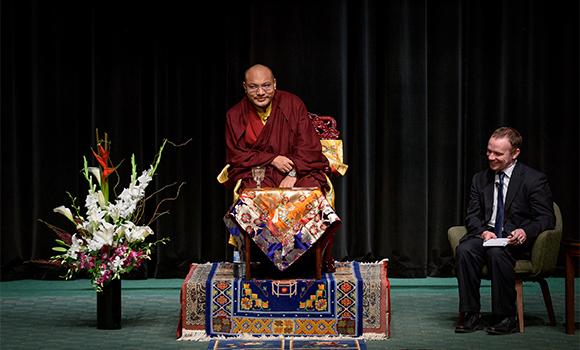
(March 19, 2015 –San Francisco, California) In the early hours of this Thursday morning, as commuters sped past intent on reaching their workplace, the sidewalks of 19th Avenue in San Francisco outside the teachings site took on the atmosphere of a street festival. Long-lost Dharma friends embraced, joyful to share the anticipation of the morning with His Holiness the 17th Karmapa. When the doors opened at 8 am, the party moved indoors. A Who’s Who of the California Dharma scene could be compiled by listing all those who stood greeting one another in the aisles, as members of the Kagyu Droden Kunchab center bustled around putting the final touches on the stage setting. The Dharma center’s founder and resident teacher, Lama Lodro, himself stood calmly greeting guests and answering his staff’s string of final queries.
Once His Holiness the Karmapa had arrived, he joked that although he had been asked by the inviters to give a talk, they had told him there was no particular topic but rather they would be happy to hear whatever came to his mind to say. Unlike the sea of college students that had stretched out before him at Stanford University, at this Dharma teaching His Holiness the Karmapa was faced with many a grey head. He noted that he recognized many students of the 16th Karmapa in the audience. Since so many of those present were long-term Buddhist practitioners, he said, he would make some comments on practicing the Dharma, and proceeded to offer them a powerful teaching on working skillfully with some of our most negative states of mind.
The Karmapa acknowledged that it is indeed very important to set aside some time each day, whether in the morning or afternoon, for our formal practice.
“Formal practice is like a time of the day when we recharge our batteries,” he explained. “Throughout the day we have many things to do and sometimes our minds become quite disturbed. It’s very helpful to set aside some time where we’re only concentrating on relaxing our body and mind. This helps to pacify and tame our mind.
“However, our practice should not be simply for the sake of relaxing,” he continued. “Relaxing and pacifying the mind is of course one component, but we need to accomplish an aim superior to that.”
Our practice ought to yield greater skill in dealing with our emotions, and train us to apply antidotes to our mental afflictions, or disturbing emotions, known in Sanskrit as ‘kleshas’.
The Karmapa pointed out that sometimes these days meditation and spirituality are used for commercial purposes. We might go to a spiritual resort for a weekend, where we might have the chance to do some meditation, some yoga, relax a bit, have a ‘spiritual massage’ and feel refreshed and pleasant, he said.
“But actually there is no guarantee that true dharma practice will feel refreshing,” the Karmapa said. “In fact, sometimes dharma practice can be rather unpleasant and uncomfortable. It involves intensive exercise for our mind.
“It’s not easy,” he cautioned. “This is because dharma practice involves changing our old habits and replacing them with new habits. We need to learn how to let go of our destructive emotions and mental afflictions and then instill new habits of loving-kindness and compassion. Dharma practice is about transforming our character, our personality, our own personal nature, and that can be difficult.
“If our character involves flaws that are harmful, then the dharma says this is what needs to be transformed,” the Karmapa pointed out. “For example, if we are someone who has a strong character that involves a great deal of anger or jealousy, then this needs to be transformed. By changing our mind, we change our personality, and by changing our personality, we change our life.”
The Karmapa explained that if we are able to relate to our emotions skillfully, it is also possible to use them to progress on our spiritual path.
“Usually it is the kleshas controlling us and not us controlling the kleshas,” he stated. “If we are completely overwhelmed and governed by our mental afflictions, then it will be very difficult for us to take them as the path. In order for us to be able to do that, we need to have some control over our disturbing mental events. This is something that comes about through a gradual process; it is very difficult to gain this ability from the very beginning.”
Next His Holiness described two stages of relating to our kleshas. First comes what he said can be described as the outer stage, where we engage in the formal aspects of meditation, study and contemplation, thereby collecting methods or tools that can serve as antidotes. At the second stage, the inner stage, change takes place on a more internal level, where we recognize the mental afflictions that are present within our own minds and directly work with them.
“It is very important that our practice create some distance between our mind and the mental afflictions,” the Karmapa instructed. “If we practice and practice, but still end up in a place where there is no separation between our mind and the mental afflictions at all, this is a sign that our practice really is not penetrating through to the key point.
“We need some attitude of disgust or revulsion toward our mental afflictions and a desire to part from them. If we do not have that revulsion, then it is going to be difficult for us to get past the mere outer stage of just going through the forms of meditation. We are unlikely to arrive at the ultimate purpose of meditation, which is to part from our afflictive mental states.”
His Holiness explained that when the force of our mental afflictions begins to lessen, it becomes increasingly easy for positive qualities such as loving-kindness and compassion to flourish in their place.
“Compassion is not just the mind or heart that understands the suffering of others or has warm sentiments toward others. Rather, compassion is the mind that realizes that the sufferings of others are actually a part of oneself. Compassion is the heart that bears unbearable love for sentient beings.”
The Karmapa finished by reflecting on his own, long journey to arrive where he was then.
“It has been more than 15 years now since I escaped Tibet for India,” he said. “When I did that, I left a note on my table in Tibet with my reason for leaving.
“What I wrote is that a main reason why I left Tibet was because I was not receiving the opportunity to meet with the many friends and disciples I have in foreign countries. And my thought at that time was if I could go to the noble land of India—which is a free country—then I would have many more opportunities to see my friends throughout the world.
“I really feel that maybe now I am getting closer to fulfilling the hopes and aspirations that I made 15 years ago. I have great trust in this.”
On that hopeful note, His Holiness the Karmapa closed the session and departed for a private visit of the Dharma center that was hosting the morning’s teaching.


